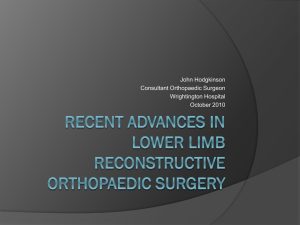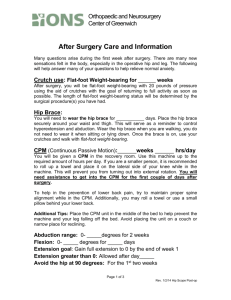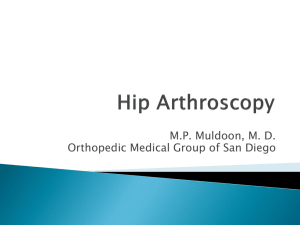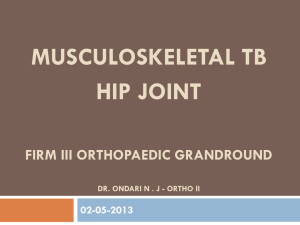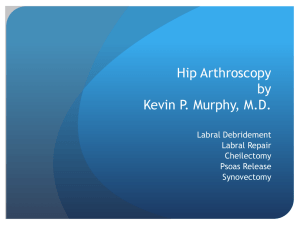Click Here for Our Patient Guide to Total Hip Replacement
advertisement
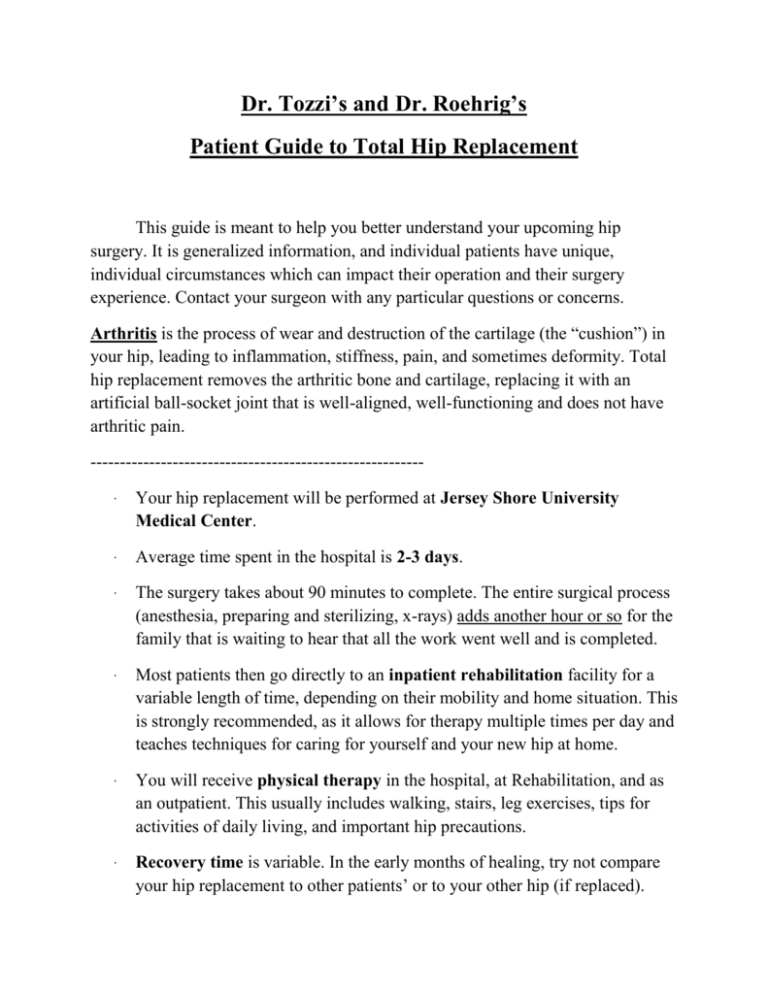
Dr. Tozzi’s and Dr. Roehrig’s Patient Guide to Total Hip Replacement This guide is meant to help you better understand your upcoming hip surgery. It is generalized information, and individual patients have unique, individual circumstances which can impact their operation and their surgery experience. Contact your surgeon with any particular questions or concerns. Arthritis is the process of wear and destruction of the cartilage (the “cushion”) in your hip, leading to inflammation, stiffness, pain, and sometimes deformity. Total hip replacement removes the arthritic bone and cartilage, replacing it with an artificial ball-socket joint that is well-aligned, well-functioning and does not have arthritic pain. --------------------------------------------------------· Your hip replacement will be performed at Jersey Shore University Medical Center. · Average time spent in the hospital is 2-3 days. · The surgery takes about 90 minutes to complete. The entire surgical process (anesthesia, preparing and sterilizing, x-rays) adds another hour or so for the family that is waiting to hear that all the work went well and is completed. · Most patients then go directly to an inpatient rehabilitation facility for a variable length of time, depending on their mobility and home situation. This is strongly recommended, as it allows for therapy multiple times per day and teaches techniques for caring for yourself and your new hip at home. · You will receive physical therapy in the hospital, at Rehabilitation, and as an outpatient. This usually includes walking, stairs, leg exercises, tips for activities of daily living, and important hip precautions. · Recovery time is variable. In the early months of healing, try not compare your hip replacement to other patients’ or to your other hip (if replaced). Each hip is unique and recovers at a different rate. Most patients can progress from a walker to cane within 2 weeks, not require the cane in 4 weeks, and be functioning well soon thereafter. Comfort, mobility, function, and strength continue to improve up to one year after surgery. · Risks an Potential Complications: The following is a (non-comprehensive) list of risks and possible complications that you will also find on your consent form for surgery. Fortunately, most are very uncommon. o · Hip Range of Motion: o · Bleeding, infection, wound healing difficulties, stiffness, dislocation, blood clots, nerve or blood vessel damage, very rare loss of extremity, leg-length inequality, fracture, loosening of the implants, wearing away or breakage of the implants, reaction to the metals, “clicking or squeaking” sensations in the hip, tendon damage or failure, failure of surgery to relieve all of the pain, loss of function, need for more surgery, and anesthesia risks not limited to stroke, heart attack, death Functional hip range of motion will come with time. There is less urgency to regain motion like there is with knee replacements. In fact, you will be taught the important positions/movements to avoid in order to lower the risk of the hip dislocating (“popping-out of joint”). Such precautions include: avoiding low chairs, sofas, toilets, and extreme internal rotation of the hip. The Implants: o · The new hip surface will be metal-on-polyethylene (plastic), ceramic, or metal-on-metal. Your surgeon will decide with you which is the best option. Most hip replacements are inserted without cement. The Incision: o Your first post-operative visit to your surgeon’s office is about 2-3 weeks from your surgery date. The staples that close your incision will either be removed at rehab or in the doctor’s office approximately 2 weeks from surgery. o The incision must be kept dry until the staples are removed. You should not immerse the hip in water (bath, pool, lake, ocean) for at least 4 weeks from surgery. · Blood thinners will be prescribed after your surgery to help reduce the risk of blood clots, a well-known concern with joint replacements. Examples of these medications include Xarelto, Arixtra, Lovenox, Coumadin, and Aspirin. The duration of use of these medicines may vary from 2-7 weeks. · Driving may resume after: LEFT hip replacement – when off narcotic pain medicines and able to get in and out of the car on your own RIGHT hip replacement – when off narcotic pain medicines and able to step on the brake quickly and firmly (usually ~3-4 weeks) · Returning to work varies on your recovery and your duties at work. It may be as soon as a few weeks, or as long as a few months. · You may travel when you are comfortable and have finished the postoperative course of blood thinners, but we strongly recommend taking a break every hour during long trips to get up and stretch and walk. The risk of blood clots is higher than usual in the post-operative period. · Sports and activities that you can participate in are numerous. You should avoid high and repetitive impact activities like running, jumping, and open field sports including soccer, football, lacrosse, and aggressive basketball. · Dental work: Antibiotics will be prescribed to you prior to any dental work or invasive medical procedure in the future. This will help lessen the risk of bacteria in your mouth reaching your blood stream and your hip joint. Please call your surgeon for this prescription a few days before your appointment. Avoid non-urgent dental work and procedures for 3 months following your hip replacement. · What else to expect: o It is normal for the hip and buttock to have some swelling. Also, the operative leg will tend to feel heavy and look somewhat swollen after surgery. Muscle spasms in the thigh and buttock are normal during the first few weeks. o Numbness of the skin around your incision is very common and usually improves with time, but may always feel different to the touch. Incisional drainage lasting more than 14 days should be brought to the attention of your surgeon. o On occasion, your legs may necessarily need to be a different length in order to maintain hip stability. This is rare but a known possibility, which can be addressed with a small lift in your other shoe. o Your new hip may set off metal detectors (airport, courthouse, etc.) and no letter or card from your doctor will change how security workers handle this. o Hip replacements can last a very long time. There is an 80-90% chance that your joint replacement will still be functioning well 20 years after your surgery. It is impossible to predict how long your new hip will last before more surgery may be necessary to change out worn or loose parts. The newest technology is improving the lifespan of these implants. o Minimally invasive surgery and computer-assisted surgery have a role in certain situations. Please refer to the following link for the American Association of Hip and Knee Surgeons position statement on these issues: http://www.aahks.org/patients/resources/MIS_Patients.pdf http://www.aahks.org/patients/resources/CAOSpositionstatement.pdf · Things to be concerned about include: Painful leg swelling Worsening redness Persistent drainage from the incision Fever >101 degrees *These symptoms should prompt a call to your surgeon’s office.

